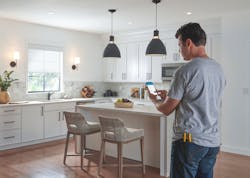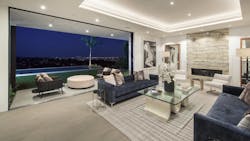In 2022, the global market for commercial and residential smart lighting alone was worth $13.5 billion, according to IMARC Group. By 2028, the research firm expects it to top $41.2 billion. Those figures are big partly because networked lighting is now a mainstream technology: a feature that builders are increasingly making standard and that homeowners want for new construction and remodels alike. Networked lighting and low-voltage smart home systems such as motorized window shades can be a lucrative part of your business.
“We do a lot of new construction at the higher end, so pretty much all my houses now have some form of smart home,” says Drew Swansborough, owner of Definitive Electric in Abbotsford, B.C., Canada. “Our builders will put in a starter kit, two or three switches, and the homeowners love them. They’re like, ‘Can we add more?’ We’ve never had somebody who doesn’t like it once they lived with it.”
Networked lighting often is one component in a larger smart home ecosystem, so it opens the door for electrical contractors to expand into those adjunct technologies for additional revenue and market differentiation. For example, Swansborough initially did only smart lighting.
“I was in a training session, and the rep goes, ‘Who wants to sell [motorized] shades?’ It’s 30 to 35 of us in there, and they’re all my competitors. Nobody puts their hands up. I’m like, ‘Well, I guess I’m going to.’”
Another example is speech control, which can be particularly attractive for seniors and people with mobility issues because it frees them from crossing the room to flip a switch.
“We see a lot of voice control for lighting,” says Rich Shumway, field supervisor at Hyattsville, Md.-based Wilcox Electric. “I believe most people have smart lighting installed to control them with their smart speakers and set up lighting scenes or routines.
“Personally, I love that when I walk through my front door and say, ‘Hey Google. I’m home,’ and all my first-floor lights turn on. When I wake up in the morning, I say, ‘Hey Google. Good morning,’ and my kitchen lights turn at 30% brightness.”
Not just neat-o, but necessary
Gee-whiz applications, such as asking lights to turn themselves on or off, are one reason why homeowners buy networked lighting. Another more mundane motivation is helping architectural features meet code requirements.
“We’re getting a lot of phone calls [where] it’s not that they want smart homes; they just want the shades because they have really high windows or there’s a lot of glare,” Swansborough says. “In Canada, we can’t have cords hanging off shades for safety reasons so kids don’t strangle themselves. So when you have a window that’s 15 feet up, what are you going to do?”
Motorized shades can also help homeowners meet energy-efficiency goals, especially when paired with sunlight sensors and other devices.
“That will save a huge amount: another 15%, probably, just in the summer,” Swansborough says.
Smart shades can be integrated with lighting as another way to reduce a home’s carbon footprint or even take it off-grid.
“Daylight harvesting is an energy-efficient solution that uses sensors, smart lighting, and smart shades to ensure the right amount of light in an area,” Shumway says. “These systems brighten/dim lights and/or raise/lower shades to achieve optimum lighting levels. We have not worked on any projects that utilize daylight harvesting yet, but I am hearing about it more and more.”
This also highlights how knowledge of these use cases and technologies can give an electrical contractor an edge when targeting builders, homeowners, and interior designers in the burgeoning green market.
“It adds extra revenue for us for sure, [but] it’s also just more appealing to that customer, whether it’s a builder or a high-end homeowner,” Swansborough says. “They may only want us for electrical, but we put that bug in their ear that we do more than electrical.”
Show me the money
The electrical industry has a chronic employee shortage, with roughly 11% of all positions unfilled through 2031, according to the U.S. Department of Labor. That means most contractors are struggling to keep up as it is. So why take on additional work in the smart homes market?
One reason is to wring maximum revenue out of the limited number of employees they have by focusing on fat-margin projects. Another is to add value in the eyes of builders and homeowners by offering a bigger portfolio of services — including to the point that it eliminates the need to bring in another sub just for the smart home technologies.
“Electricians are a dime a dozen out here,” Swansborough says. “It’s kind of a race to the bottom. We have a really good reputation, but builders say, ‘Your quote is $5,000 to $10,000 more.’ Okay, so be it because I know the quality of work we do versus what other people quote and end up giving you.
“We were trying to just diversify ourselves out of that, and that’s where smart houses and networking came in. We kind of give everybody a package deal. Shades are more of a gravy thing for us. If we sell them, cool. They’re a high-margin item.”
Motorized shades are also typically the first thing cut when the budget gets tight, Swansborough says. But that doesn’t necessarily mean lost business.
“We’re rough wiring the house for the shades because six months down the line, you may have the money, and now you want shades,” Swansborough says. “The wire is cheap in the grand scheme of things. Just put the infrastructure in, and then you have the ability to play around with it down the line.”
If electricians won’t do it, someone else will.
Considering the opportunities, why don’t more electrical contractors pursue the smart home market?
“Where I think a lot of electricians get lost is they limit themselves to just wiring,” Swansborough says. “I’ll hire guys and say, ‘We run low voltage,’ and they’ll be like: ‘I don’t really want to do that. I just want to run wire.’ Well, what’s the difference? I think it’s more of a mentality thing.”
Initially, manufacturers of smart home technologies assumed that electrical contractors would jump at the chance to sell and install their products — only to get the cold shoulder.
“They said, ‘We have these awesome products, and we would love to sell them to electricians,’” says Joe Borress, CEO of Malibu, Calif.-based Tri Star Electric & Automation. “They looked at it and said: ‘I don’t want anything to do with this. I don’t even know how to use a computer.’ They were just straight-ahead electricians.’ Then these manufacturers said: ‘Holy crap! Nobody wants to buy our stuff. What are we going to do? Oh, let’s get the AV guys because they’re already in there doing the speakers and the TVs.’”
In the process, electrical is effectively ceding the market and its margins to audio-video (AV) integrators, IT firms, security contractors, and even cable broadband providers.
“The electrician gets just the grunt work on the job, doesn’t get any of the smarts and parts and any of the glory of the markup,” Borress says. “That’s why now is the time for electricians that do residential to jump on board. I believe that in time, it will be in the commercial business, as well, where AV integrators are doing the networks for office buildings, video conferencing, voice and data securities, access control, and surveillance. They will eventually get into lighting and temperature control, as well.”
Lighting and other smart home/smart building technologies all require not just a network, but a reliable, secure one. That’s another business opportunity for electrical contractors willing to invest in skills such as designing and installing Wi-Fi.
“The hardest thing we’re finding with the low-voltage side of things is nobody out here thinks about their networking,” Swansborough says. “They think that their internet provider gives them their little Wi-Fi modem, and that’s as good as it gets. We’ve done jobs where we’ve put access points in the house, and people are amazed at how good their Wi-Fi can actually be.”
By offering network design and installation, electrical contractors also avoid the risk that their perfectly installed lighting, shades, and other smart technologies aren’t undermined by someone else’s shoddy work. This also benefits the builder and homeowner because they don’t have to deal with two contractors pointing fingers at each other.
“Having everything under one [roof] makes everybody’s life easier — lots easier,” Swansborough says. “Now I don’t have to talk to low-voltage guys or anything like that. I don’t have to rely on them to make my stuff work.”
Knowledge is power
Although networked lighting and other smart home technologies are now a mainstream phenomenon, the most lucrative opportunities tend to be at the high end of the market. It’s not just that a bigger home has a bigger budget. It’s also because a week spent installing dozens of networked lights, motorized window shades, and other smart devices at a single house is more profitable than running all over town doing a couple each at dozens of single-family homes.
“On a $300,000 [project], we’re going to have a much smaller budget — probably like $3,000 to $5,000 versus $20,000 to $30,000 [on a million-dollar home],” John Moffitt, an Overland Park, Kan.-based realtor and custom home builder, told EC&M in 2020.
For some electrical contractors, networked lighting and other smart home technologies have become the tail that wags the dog.
“It gives us a huge advantage over our competition,” Swansborough says. “I’ve had builders contact us just because I do smart homes and then offering the electrical on the side of that. Having everything in-house makes it more appealing to them.”
Some have gone even further by offering a bundle of services, which can help capture a bigger share of a project budget. One example is New York City-based James Stanley NY, which specializes in high-end residential renovations.
“I started out as an architect and interior designer, and I was so sick of dealing with subcontractors,” Stanley says. “I have an engineering background. An accountant of mine said, ‘Why don’t you get licensed, and we’ll pull this in-house?’ Now we’re able to sit at the table and be the contractor, the architect, and the design firm. It puts me in a really unique position to wear all the hats and see things from many different angles.”
That can also help me compete against firms that can’t provide a holistic view of a project because they offer only some services. The catch is that it takes money to make money: For this strategy to work, electrical contractors must invest in skills such as programming.
“Some of these systems are easy to set up while others require special training,” Shumway says. “For instance, we had to complete training to become a [manufacturer-certified] pro shop and download their programming software. We paid a couple of our electricians for three or four hours to go through the training. Then we bought a few of the switches and installed them in our office so our guys could do some real programming. We don’t want them to be learning this on the job.”
Another example is knowledge of fixtures and finishes.
“If you’re going to sell lighting, you need to know everything about that,” Borress says. “Go meet with the manufacturer. They’ll train you for free. What size are its fixtures? How can they get orientated? Are they trimmed? Are they good for insulated ceilings? Are the lenses interchangeable? All that stuff.”
Custom homes offer the most opportunity for electrical contractors to demonstrate and monetize their design expertise.
“The developers, all they care about is ROI,” Borress says. “Nine out of 10 times, when an electrical contractor gets a set of plans for a commercial-style MDU, they have no input in anything. They’re just, ‘Give me a price for what’s on the drawings.’ There are no cool bespoke brands.”
Another challenge is getting a seat at the table early on in a project before budgets are spent and designs are locked in. For example, when electrical is there with the builder, homeowner, and architect, it’s an opportunity to bring up how daylight harvesting can meet the project’s energy-efficiency goals.
“Just like an architect is hired and interior decorators hired, we should be hired as consultants,” Borress says. “If I was a developer, I would want to meet with electrical contractors and electrical designers like ourselves because we also do a lot of design and consulting, not just installs. We’re really trying to push more toward the design part of our business because I feel like it’s really undervalued.”
Tim Kridel is an independent analyst and freelance writer. He can be reached at [email protected].





